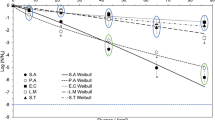Abstract
Microbial contamination is a significant issue in the food industry, often leading to foodborne illnesses. This study introduces our hot water-treated (HWT) nanostructured aluminum foil, coated with a layer of tea-tree essential oil, which works synergistically to inactivate bacteria. Our results show that this method inactivated ~ 98% of the Escherichia coli and Staphylococcus epidermidis tested. This approach also offers the benefit of robustly holding oil on the foil surface due to the superoleophilicity of the nanostructured aluminum oxide layer, further increasing its efficacy. In addition, the HWT process can be extended to other forms of aluminum-based materials.
Graphical Abstract




Similar content being viewed by others
Data availability
The datasets generated during and/or analyzed during the current study are available from the corresponding author on reasonable request.
References
D.G. Nyachuba, Foodborne illness: is it on the rise? Nutr. Rev. 68, 257–269 (2010). https://doi.org/10.1111/j.1753-4887.2010.00286.x
S. Hoffmann, B. Maculloch, M. Batz, Economic burden of major foodborne illnesses acquired in the United States. Econ Cost Foodborne Illnesses United States 1–74 (2015)
CDC. How food gets contaminated—the food production chain. Cent. Dis. Control Prev. 3–5 (2017)
C. Manyi-Loh, S. Mamphweli, E. Meyer, A. Okoh, Antibiotic use in agriculture and its consequential resistance in environmental sources: Potential public health implications. Molecules (2018). https://doi.org/10.3390/molecules23040795
B.M. Marshall, S.B. Levy, Food animals and antimicrobials: impacts on human health. Clin. Microbiol. Rev. 24, 718–733 (2011). https://doi.org/10.1128/CMR.00002-11
I.A. Jones, L.T. Joshi, Biocide use in the antimicrobial era: a review. Molecules (2021). https://doi.org/10.3390/molecules26082276
W. Yin, Y. Wang, L. Liu, J. He, Biofilms: the microbial “protective clothing” in extreme environments. Int. J. Mol. Sci. (2019). https://doi.org/10.3390/ijms20143423
E.P. Abraham, The Antibiotics. Compr. Biochem. 11, 181–224 (1963). https://doi.org/10.1016/B978-1-4831-9711-1.50022-3
M.K. Swamy, M.S. Akhtar, U.R. Sinniah, Antimicrobial properties of plant essential oils against human pathogens and their mode of action: an updated review. Evid.-Based Complement Altern. Med. (2016). https://doi.org/10.1155/2016/3012462
G. Klein, C. Rüben, M. Upmann, Antimicrobial activity of essential oil components against potential food spoilage microorganisms. Curr. Microbiol. 67, 200–208 (2013). https://doi.org/10.1007/s00284-013-0354-1
S. Burt, Essential oils: their antibacterial properties and potential applications in foods—a review. Int. J. Food Microbiol. 94, 223–253 (2004). https://doi.org/10.1016/j.ijfoodmicro.2004.03.022
J.B. Sharmeen, F.M. Mahomoodally, G. Zengin, F. Maggi, Essential oils as natural sources of fragrance compounds for cosmetics and cosmeceuticals. Molecules (2021). https://doi.org/10.3390/molecules26030666
J. Sharifi-Rad, A. Sureda, G.C. Tenore, M. Daglia, M. Sharifi-Rad, M. Valussi et al., Biological activities of essential oils: from plant chemoecology to traditional healing systems. Molecules (2017). https://doi.org/10.3390/molecules22010070
F. Nazzaro, F. Fratianni, L. De Martino, R. Coppola, V. De Feo, Effect of essential oils on pathogenic bacteria. Pharmaceuticals 6, 1451–1474 (2013). https://doi.org/10.3390/ph6121451
L. Wang, C. Hu, L. Shao, The-antimicrobial-activity-of-nanoparticles–present-situati. Int. J. Nanomed. 12, 1227–1249 (2017)
T.J. Beveridge, Structures of gram-negative cell walls and their derived membrane vesicles. J. Bacteriol. 181, 4725–4733 (1999). https://doi.org/10.1128/jb.181.16.4725-4733.1999
A.H. Delcour, NIH Public Access 1794(5), 808–816 (2010). https://doi.org/10.1016/j.bbapap.2008.11.005.Outer
J.T. Seil, T.J. Webster, Antimicrobial applications of nanotechnology: methods and literature. Int. J. Nanomed. 7, 2767–2781 (2012). https://doi.org/10.2147/IJN.S24805
L.B. Hassan, N.S. Saadi, T. Karabacak, Hierarchically rough superhydrophobic copper sheets fabricated by a sandblasting and hot water treatment process. Int. J. Adv. Manuf. Technol. 93, 1107–1114 (2017). https://doi.org/10.1007/s00170-017-0584-7
N. Saadi, K. Alotaibi, L. Hassan, Q. Smith, F. Watanabe, A.A. Khan et al., Enhancing the antibacterial efficacy of aluminum foil by nanostructuring its surface using hot water treatment. Nanotechnology 32, 325103 (2021). https://doi.org/10.1088/1361-6528/abfd59
J. Gupta, D. Bahadur, Defect-mediated reactive oxygen species generation in Mg-substituted ZnO nanoparticles: efficient nanomaterials for bacterial inhibition and cancer therapy. ACS Omega 3, 2956–2965 (2018). https://doi.org/10.1021/acsomega.7b01953
Q. Smith, K. Burnett, N. Saadi, K. Alotaibi, A. Rahman, K. Al-Mayalee et al., Nanostructured antibacterial aluminum foil produced by hot water treatment against E. coli in meat. MRS Adv. 6, 695–700 (2021). https://doi.org/10.1557/s43580-021-00112-2
K. Burnett, Q. Smith, A. Esparza, N. Saadi, J. Bush, T. Karabacak, The antibacterial efficacy of aluminum oxide nanostructures by hot water treatment for HVAC systems. MRS Adv. 6, 701–705 (2021). https://doi.org/10.1557/s43580-021-00126-w
H.J. Dorman, S.G. Deans, Antimicrobial agents from plants: antibacterial activity of plant volatile oils. J. Appl. Microbiol. 88(2), 308–316 (2000). https://doi.org/10.1046/j.1365-2672.2000.00969.x
T.C. Dakal, A. Kumar, R.S. Majumdar, V. Yadav, Mechanis tic basis of antimicrobial actions of silver nanoparticles. Front. Microbiol. 7, 1831 (2016). https://doi.org/10.3389/fmicb.2016.01831
S.M. Dizaj, F. Lotfpour, M. Barzegar-Jalali, M.H. Zarrintan, K. Adibkia, Antimicrobial activity of the metals and metal oxide nanoparticles. Mater. Sci. Eng. C 44, 278–284 (2014). https://doi.org/10.1016/j.msec.2014.08.031
S. Ghosh, S. Patil, M. Ahire, R. Kitture, S. Kale, K. Pardesi, S. Camera, J. Bellare, D. Dhavale, A. Jabgunde, B. Chopade, Synthesis of silver nanoparticles using Dioscorea bulbifera tuber extract and evaluation of its synergistic potential in combination with antimicrobial agents. Int. J. Nanomed. 7, 483–496 (2012). https://doi.org/10.2147/IJN.S24793
M. Sienkiewicz, M. Łysakowska, M. Pastuszka, W. Bienias, E. Kowalczyk, The potential of use basil and rosemary essential oils as effective antibacterial agents. Molecules 18(8), 9334–9351 (2013). https://doi.org/10.3390/molecules18089334
A. Ultee, M.H. Bennik, R. Moezelaar, The phenolic hydroxyl group of carvacrol is essential for action against the food-borne pathogen Bacillus cereus. Appl. Environ. Microbiol. 68, 1561–1568 (2002). https://doi.org/10.1128/AEM.68.4.1561-1568.2002
C.M. Mann, S.D. Cox, J.L. Markham, The outer membrane of Pseudomonas aeruginosa NCTC 6749 contributes to its tolerance to the essential oil of Melaleuca alternifolia (tea tree oil). Lett. Appl. Microbiol. 30, 294–297 (2000). https://doi.org/10.1046/j.1472-765x.2000.00712.x
Author information
Authors and Affiliations
Corresponding author
Ethics declarations
Conflict of interest
The authors declare that they have no competing interests.
Additional information
Publisher's Note
Springer Nature remains neutral with regard to jurisdictional claims in published maps and institutional affiliations.
Rights and permissions
Springer Nature or its licensor (e.g. a society or other partner) holds exclusive rights to this article under a publishing agreement with the author(s) or other rightsholder(s); author self-archiving of the accepted manuscript version of this article is solely governed by the terms of such publishing agreement and applicable law.
About this article
Cite this article
Smith, Q., Burnett, K., Ali, N. et al. Enhancing the antibacterial efficacy of hot water treated nanostructured aluminum foil by essential oil. MRS Communications 13, 336–342 (2023). https://doi.org/10.1557/s43579-023-00349-y
Received:
Accepted:
Published:
Issue Date:
DOI: https://doi.org/10.1557/s43579-023-00349-y




